本文由 B.L.U.E.建筑设计事务所 授权mooool发表,欢迎转发,禁止以mooool编辑版本转载。
Thanks B.L.U.E. Architecture Studio for authorizing the publication of the project on mooool, Text description provided by B.L.U.E. Architecture Studio.
B.L.U.E.建筑设计事务所:在距离上海,苏州车程一个半小时左右的地方,有一个小村庄:计家墩村。这里曾经是一座典型的江南水乡,随着时代发展,村子人口逐渐减少,空心化愈加严重。于是乡镇政府邀请专业团队,对村子进行了再次开发和改造。
B.L.U.E. Architecture Studio:As a typical picturesque Chinese Jiangnan town, the village of Jijiadun locates about 1.5-hour drive from the central city of Shanghai. With the rapid development of urbanization in China, the problem of rural hollowing-out is becoming increasingly serious.
▼项目鸟瞰视频 Project bird’s eye video
为了激发村子活力,计家墩村依托原有乡村风光,引入文化创意产业,吸引了一批城市来的“新村民”,形成了一个新的乡村理想生活社区。而我们此次的项目–江南半舍民宿,就坐落于此。民宿的位置在村子入口处,基地被一条小河三面环绕,不远处便是农田。In order to revitalize the village, the government of the local rural township invited a team of professionals to re-develop and renovate the village. By introducing the cultural and creative industries into the village while respecting its rural scene and culture, Jijiadun village is attracting “new villagers” from the cities and thus forming a new dynamic rural living community. The project of BAN Villa sits at the entrance of the Jijiadun village. The site is surrounded on three sides by a small river, and there are croplands not far away from the site.
▼场地原貌 The original appearance of the venue

▼整体鸟瞰 Overall bird’s eye view
▼项目鸟瞰 Project bird’s eye view
▼树林包裹的白色建筑 White building wrapped in woods
设计理念|Concept
在项目之初,我们首先思考的是乡村和城市之间关系的新可能。从城市来到乡村的“新村民”,给乡村带来了新的产业和生活方式,增强了乡村和城市间的纽带联系,这也为半舍设计奠定了基调:一半是城市,一半是乡村。
The design team starts with rethinking the possibilities of the relations between the countryside and the city. The “new villagers” from the cities bring new industries and lifestyles to the village, which helps strengthen the bond between the village and the city. The basic context of the redevelopment of the village sets the tone for the project.
▼区位信息及设计概念 Location information and design concept
▼项目与周边的环境 Project and surrounding environment
民宿的主人,本身也是村子本地人,在这里长大。在设计交流的时候,民宿主人提出想给自己预留一片私人空间,希望以后可以回归到这里生活:一半是留给自己的私密住宅,一半是与客人共享的开放空间。这样的民宿,更像是一个开放共享的家。
The owner of the BAN Villa who grew up in the village hopes to keep a private space for himself in the project so that he can return to the village life when he grows old in the future. In this way, the project is an open and shared home. A small portion of the villa serves as a private residence for the owner, and the rest is an open space shared with guests.
▼民宿模型 Homestay model
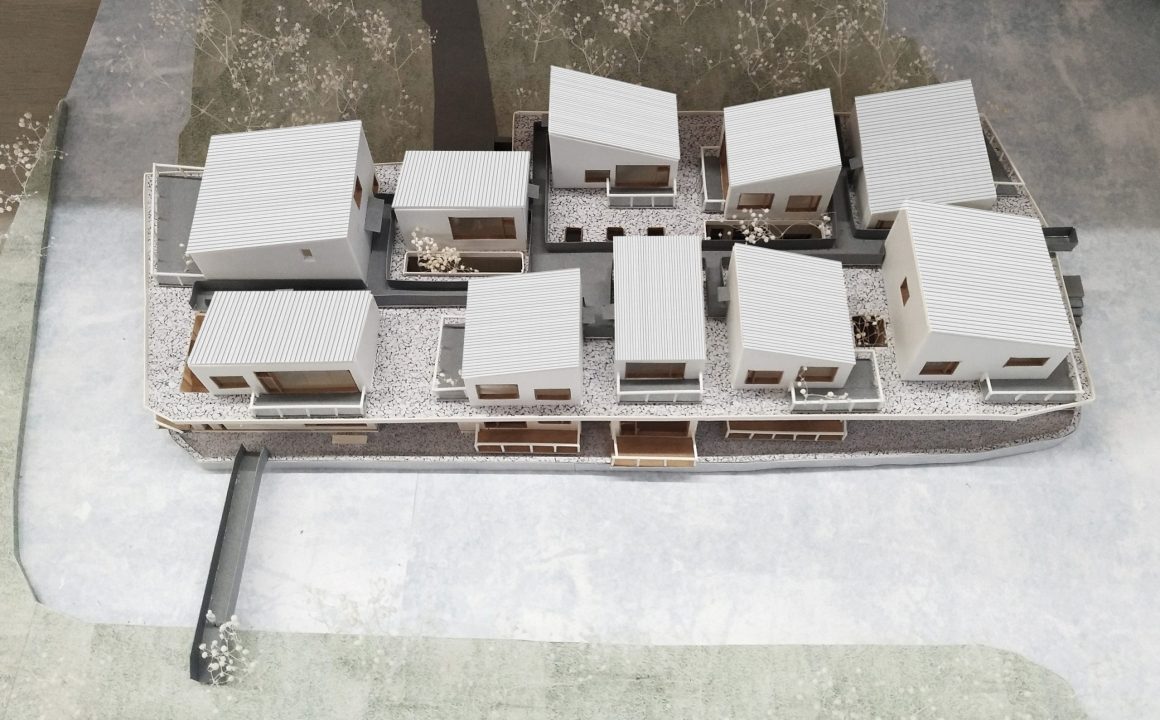
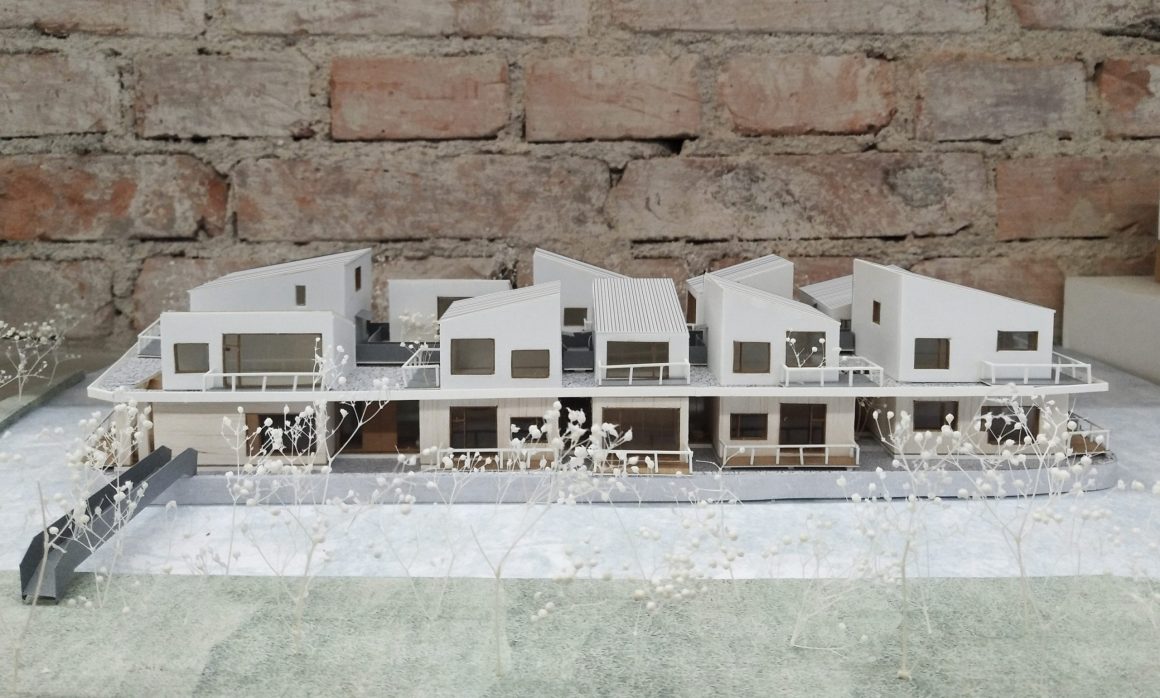
▼设计呈现与设计模型高度还原 Design presentation and design model are highly restored
同时,在打造江南半舍的时候,我们希望建筑是一个从传统水乡肌理中生长出来的,与自然更交融的空间:于是在满足功能和使用面积的前提下,我们化整为零,将一个完整的形体拆分成若干小尺度的建筑,通过排列从中建立起新的秩序。错落有序的房子,空间上既独立又相互联系,而建筑间的空隙,让自然得以渗透进室内,模糊内与外的边界。
The designers imagine the architecture of the villa as a comfortable space integrated with nature that gently grows from the texture and fabric of traditional Jiangnan watertown. The method is to break up the whole volume into several small-scale architecture and to further establish a new order by arranging and planning. The scattered volumes in an ordered way are spatially independent while interconnected in space. Due to the gaps between the architecture, nature gets the opportunity to penetrate into the interior, blurring the boundary between the inside and outside.
空间设计|Spatial Design
总体布局上,我们用一个连续的大空间,串联起10个独立的“盒子”,形成了建筑的平面。这些盒子有公共功能的餐厅,茶室,也有供客人居住的客房,以及民宿主人的私人生活空间。
In terms of the overall layout, the main concept is about forming ten independent boxes that are connected in series by a large continuous space. The boxes include public and social functions of restaurants, tearoom, and guest rooms. Meanwhile, these boxes also include private living space for the owner of the villa.
▼俯瞰10个独立的盒子视频 Overlooking 10 independent box videos
▼俯瞰10个独立的盒子 Overlooking 10 independent box
竖向上建筑由一个连续的屋面划分为上下两层,而两层的空间有着截然不同的体验。在建筑的一层,客房及主要功能空间,沿河面错落布置,确保每个房间都有良好的景观面同时兼具必要的私密性。
Vertically, the architecture is divided into two layers by a continuous roof plane. And the space of each level provides different sense of experience. On the first floor, guest rooms and main functional spaces are arranged in a staggered form along the riverside to ensure that each room features a good view and necessary privacy.
▼从外面看到的民宿 Homestay seen from the outside
一个连续的共享空间组织串联起各个功能房间。这个连续共享空间不仅仅是交通走廊,还可作为展览空间,共享客厅,是一个人与人相遇交流的场所。为了与环境更好的融合,将自然引入室内,我们在建筑中设置了两处天井庭院和可以开启的天窗,既满足了室内公共空间采光,更让自然的活力与生趣蔓延进室内。
A continuous communal space at this level systematically connects each functional room. The public space serves not only as a corridor, but also an exhibition space and a shared living room, and especially a place for people to meet and communicate. In addition, in order to better integrate with the local environment and introduce natural elements into the interior, the designers put two courtyards and operable skylights in the architecture, which satisfies the daylighting of interior public space while attracting the vitality of nature into the interior.
▼俯瞰民宿二楼景观视频 Video overlooking the second floor of the homestay
▼二楼空间鸟瞰 Aerial view of the second floor space
建筑二层空间更加开放自然。连续的大屋面将10栋房子分割出来,错落有序的盒子远远看去好像是一个漂浮的小小村落。屋面上铺满灰白色石子,一座开放的景观连廊架设于屋面之上串联起相互独立的房间。每个房间都设有可以走出来的露台,将室内的生活延申到了户外,在空间上二楼的房间是相互独立的,而视线上又有着彼此的联系。如果把石子比作水面,连廊比作桥,每个房子是一个小家,那这里又何尝不是一个抽象的江南水乡。
The space of the second floor appears more open and natural. The ten scattered boxes divided by the continuous large roof look like a small floating village from a distance. The rooms are mutually independent while they are visually related. The floor of the second level is mostly covered by off-white pebbles and an open corridor on the roof connects the mutually independent rooms. Each room on the second floor has a terrace, extending indoor living to the exterior. Overall, the whole villa can be considered as a micro contemporary version of a traditional Jiangnan watertown.
▼二层是连续的共享空间 The second layer is a continuous shared space
▼局部鸟瞰 Partial bird’s eye view
▼天井庭院和天窗的设计满足室内采光 The design of patio courtyard and skylight satisfy indoor lighting
▼交通连廊串联各个独立的建筑体 The traffic corridor connects the independent buildings
建筑材质选择|Materials
在建筑材质的选择上,也呼应了建筑空间的概念。以连续的大屋面为划分,上下两层采用了不同的材质。场地三面环水,周边绿植丰富,于是在一层外立面上我们采用了竹钢作为主要材质。竹钢作为自然材料不仅从质感上让建筑与环境更加融合,触感上也更加柔和有温度,给人一种放松且温暖的感受。同时,竹钢的耐候性也能很好的适应水乡的潮湿。
The choice of materials for both architecture and the interior responds to the spatial concept and strategy. In terms of the materials of architecture, the designers choose different materials for each level to project different atmosphere. The facade of the ground floor is featured by laminated bamboo since the material integrate itself respectfully with the surroundings, both natural environment and built architecture. Meanwhile, laminated bamboo delivers a warm and relaxing feeling with soft tactile. Also, the material has great weather resistance to better adapt to the local wet climate.
▼上下两层不同材质的使用和呈现 The use and presentation of different materials on the upper and lower layers
▼一层以自然材料的竹钢为主,与周边环境融合呼应 The first floor is mainly made of bamboo and steel made of natural materials, which blends with the surrounding environment
建筑二层的材质则表现得更为纯粹。墙面采用白色带肌理涂料,搭配白色哑光金属屋面,使得每个建筑单体看起来简单而干净。银灰色镀锌钢板走廊表面做了乱纹细节处理,大屋面整体铺设灰白混合大颗粒石子,二层空间整体呈现灰白色调,以绿色植物为点缀,塑造出一种静谧的空间感受。
The upper floor’s materials present a more pure atmosphere. The overall space of this level is off-white as a whole, including the white stucco for wall and matte white metal roofing. The galvanized steel sheet for the both sides of the outdoor corridor, the rough off-white pebbles on the floor, and the interspersed greenery are together shaping a quiet spatial experience. The pure whiteness shows a sense of simplicity and neatness.
▼简洁的二层以大面积的白色肌理涂料为主 The concise second layer is dominated by a large area of white texture paint
▼静谧的灰白色调空间,点缀一抹绿色 Quiet gray and white space, embellished with a touch of green
室内材质选择|New Possibility
建筑室内公共空间部分,整体以白色简约为主:墙面和天花选用米白色肌理涂料,地面是白色的水磨石。这样的空间,可以很好的映衬天井庭院所带来的光线变化。同时,也可以满足公共空间布展的功能需求。在公共空间开放的区域我们还设置了木制固定家具,配合植物和活动家具,营造出开放的共享客厅空间。
The concept of whiteness extends to the use of materials for the villa’s interior public space. The walls and ceilings are painted with off-white stucco, and the floor is paved with white terrazzo. The public white space meets the owner’s requirement of exhibiting, while it helps reflect the light changes caused by the patio courtyards.
▼利用天井种植造型树丰富室内空间 The patio is planted with modeling trees to enrich the indoor space
▼透过玻璃看到的景观 Landscape seen through glass
▼坐在室内看到的外景 Sitting indoors and seeing the exterior scene
建筑室内客房部分,有深色及浅色两种色彩搭配。材质选用上采取相同的逻辑:地面为水磨石,墙面和天花采用带有肌理的涂料。在沙发区域,卧室区域,书桌区域则是选用了触感更加柔和自然的木饰面材料。淋浴卫生间区域,选用了小颗粒石子为底料的水洗石,不仅增加了空间的肌理质感,还很好的起到了防滑的效果。
The design aims to create an open communal living space through combining wood fixed furniture, movable furniture and plants in the space. The choice of materials of the guest rooms continues the strategy of combining stucco, terrazzo and wood. The dark and light color schemes of the guest rooms share the same material strategy, providing comfortable and natural sensual experience. Besides, the exposed aggregate concrete for the shower area increases texture in a natural way, and also features with anti-slip effect.
▼沉稳的深色调客房 Calm dark room
▼客房空间示意图 Room space diagram
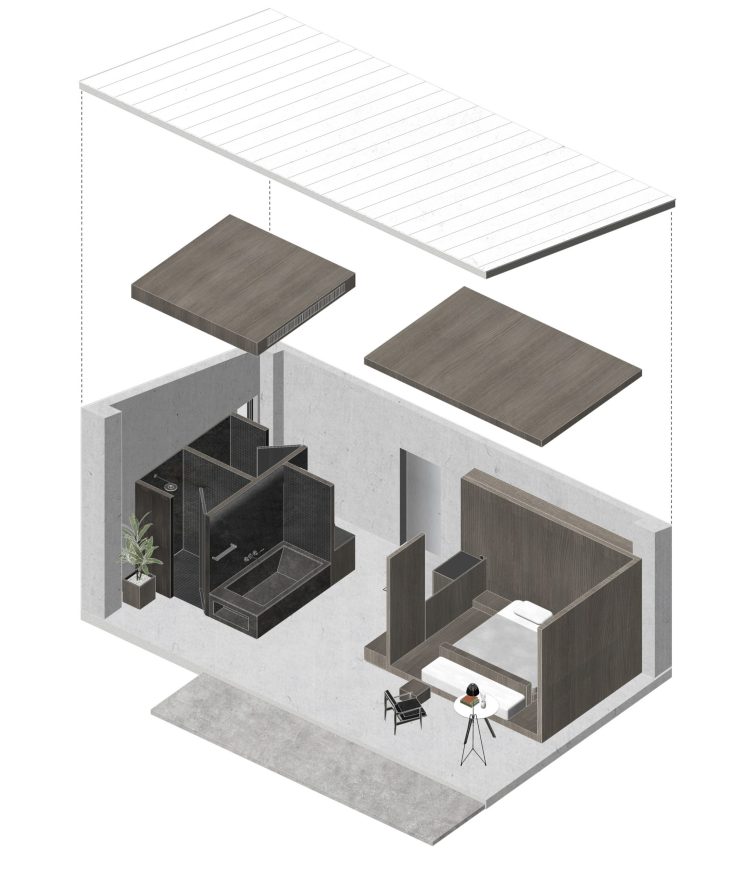
▼触感柔和自然的木饰面浅色Loft风格客房 Light-colored Loft-style room with soft and natural wood finish
▼透过大面积落地窗看到多姿的植物 See the colorful plants through the large floor-to-ceiling windows
▼Loft式客房空间示意图 Loft-style guest room space diagram

总结|Summary
在时代发展的今天,乡村的再次开发带给我们更多新的课题和可能。江南半舍项目,就是带着这样思考的一次尝试;
在江南半舍,可以享受安静闲暇的时光,体会江南水乡风情,可以偶遇半舍主人,一同品茶聊天,或是遇到更多的朋友,围炉夜话把酒言欢。
As a part of the rethinking of today’s Jijiadun Village, the project of Ban Villa is an attempt to explore new possibilities of the countryside in future. In the villa, people can enjoy quiet and cozy moments and experience local culture of Jiangnan watertown. They can also encounter the owner of the villa and enjoy tea and chat together. They can even meet new friends and communicate with each other while dining and drinking together.
▼闲暇静谧的民宿夜景 Leisure and quiet night view of the homestay
江南半舍,不仅仅是一家民宿,更为城市的人们,提供了一个乡村理想生活的新可能。
BAN Villa is more than a boutique guesthouse. It provides possibilities of new village life for urban dwellers.
▼场地总平面图 Site master plan

▼一层平面图 Floor plan
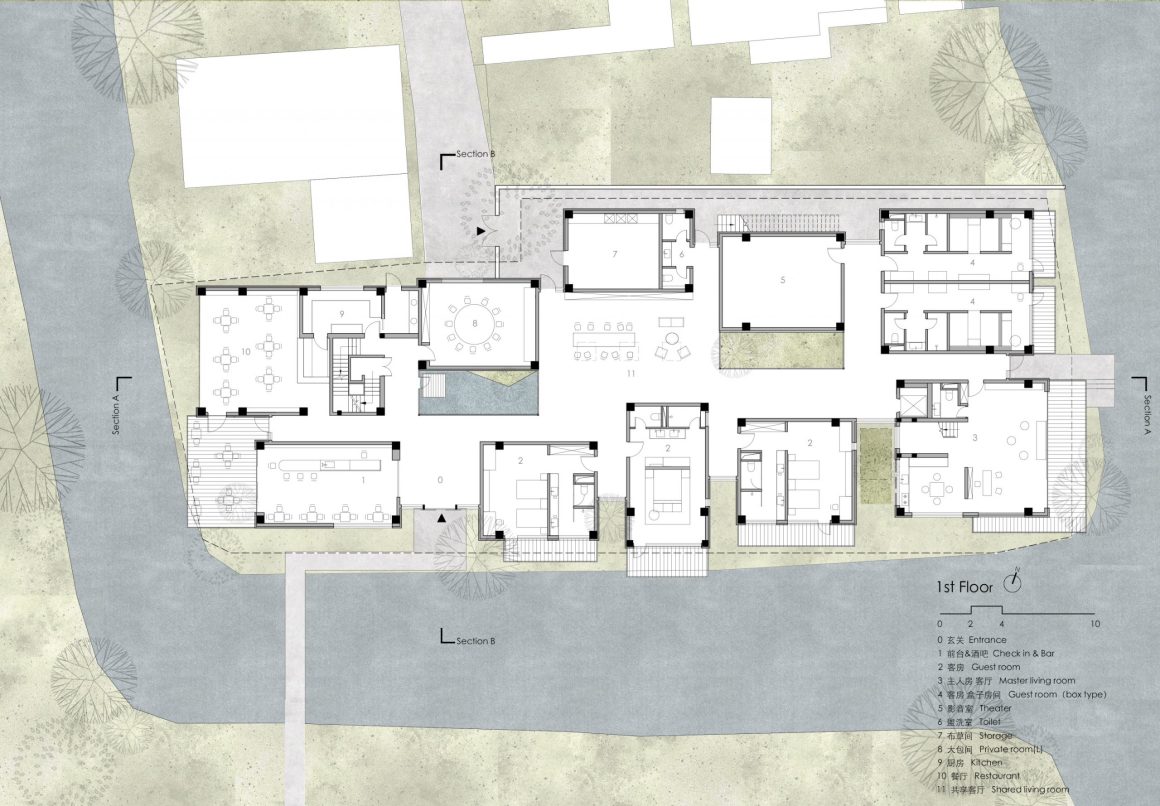
▼二层平面图 Floor plan
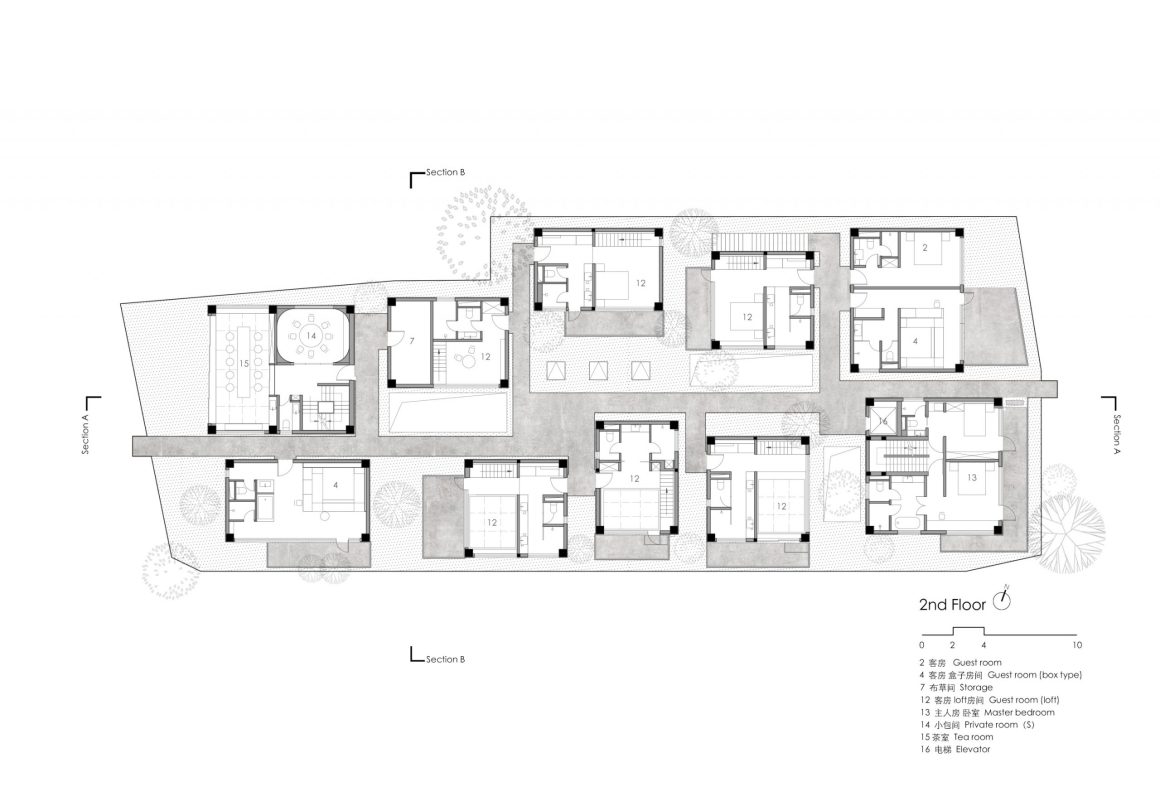
▼ 夹层平面图 Mezzanine floor plan
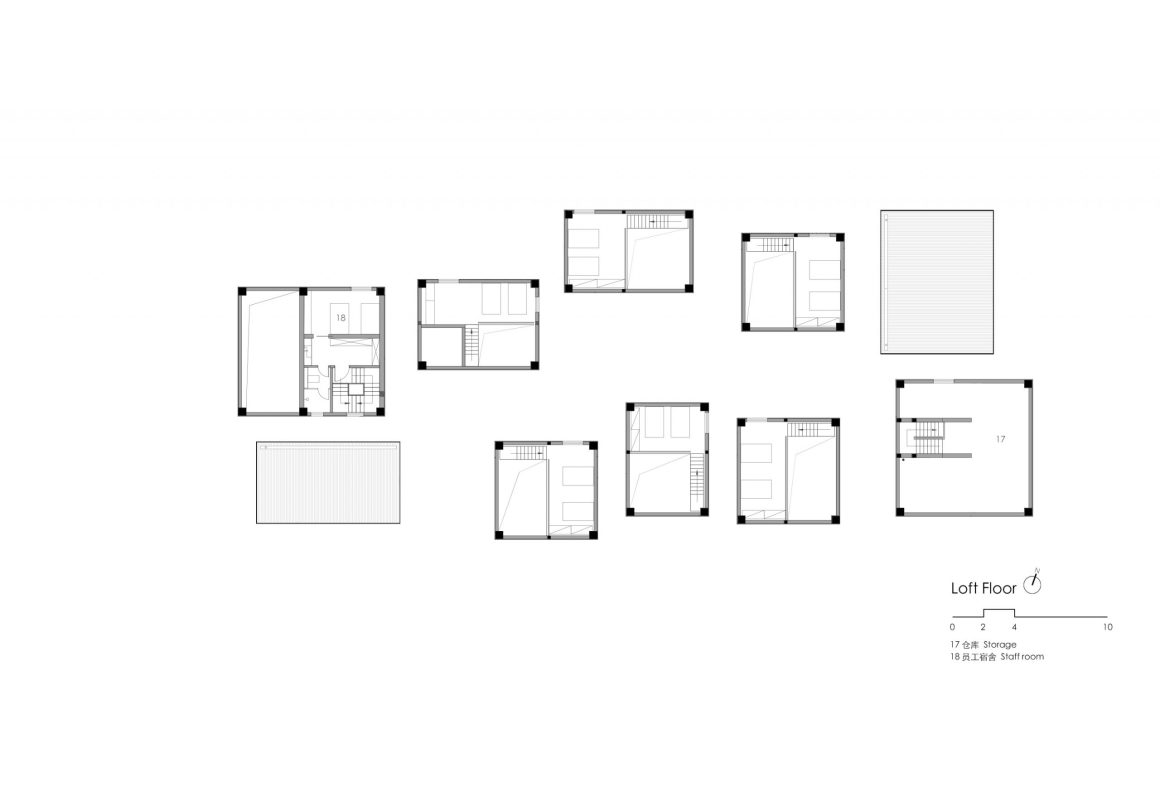
▼屋顶平面图 Roof plan

▼建筑空间轴测示意图 Schematic diagram of axonometric building space
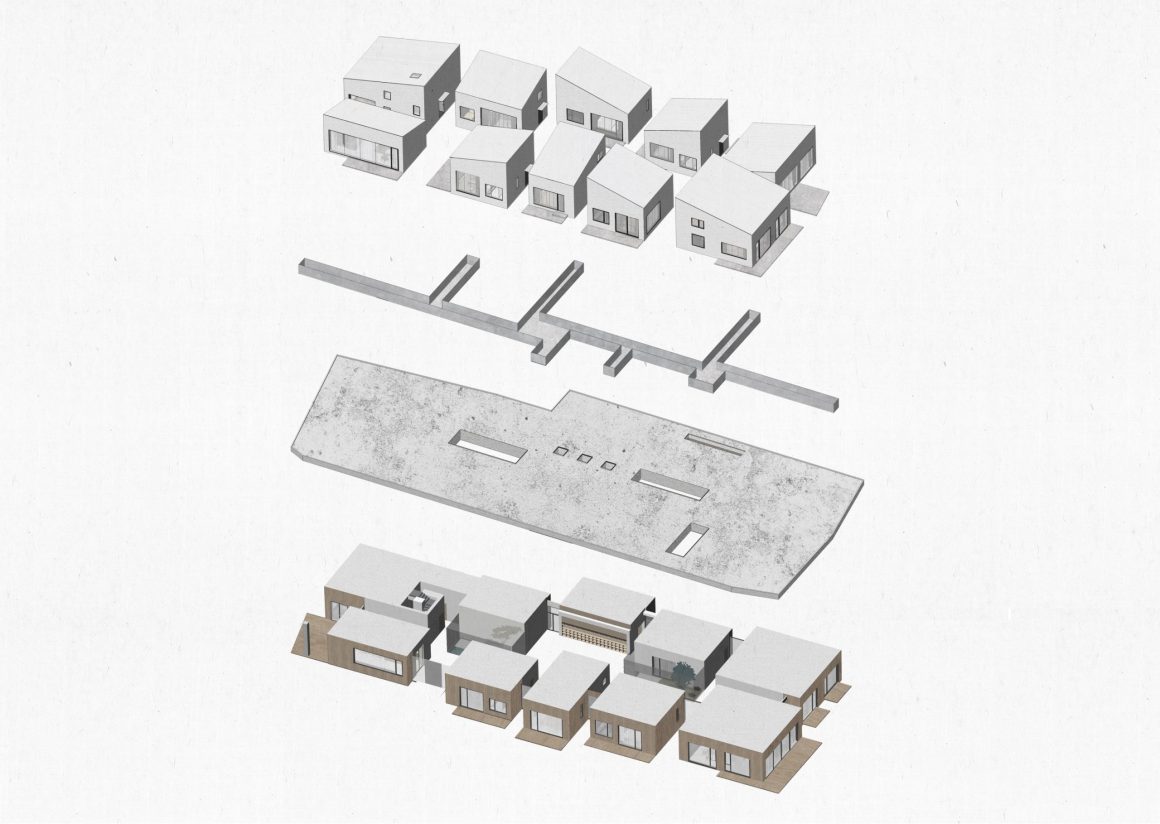
▼剖面图A Section A
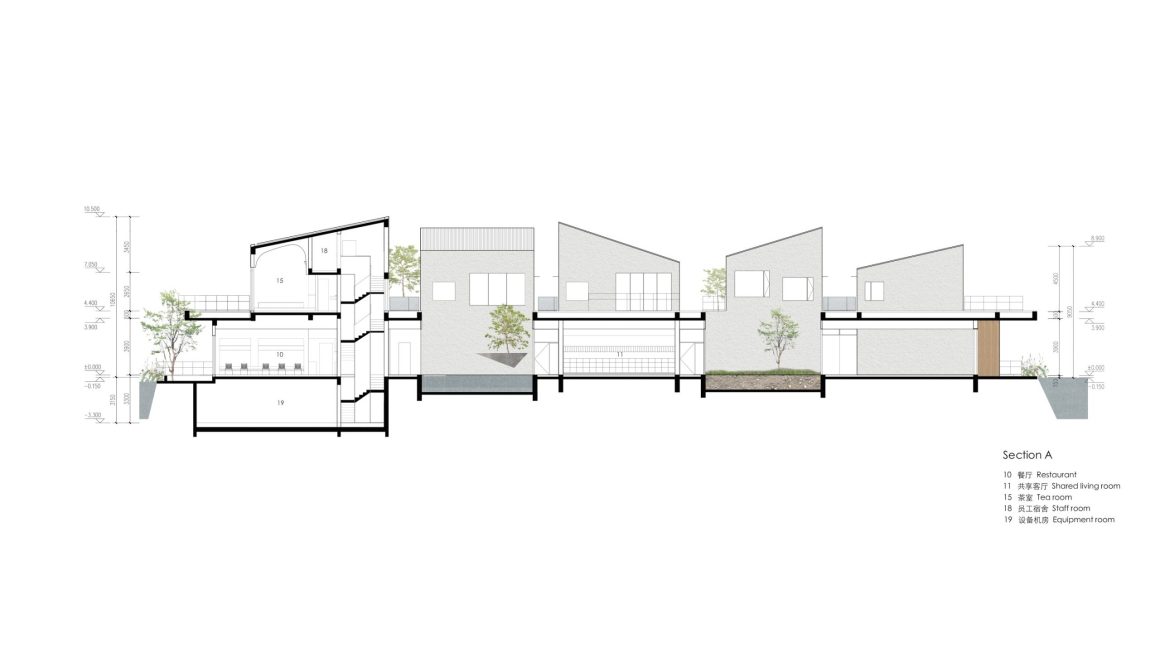
▼剖面图B Section B
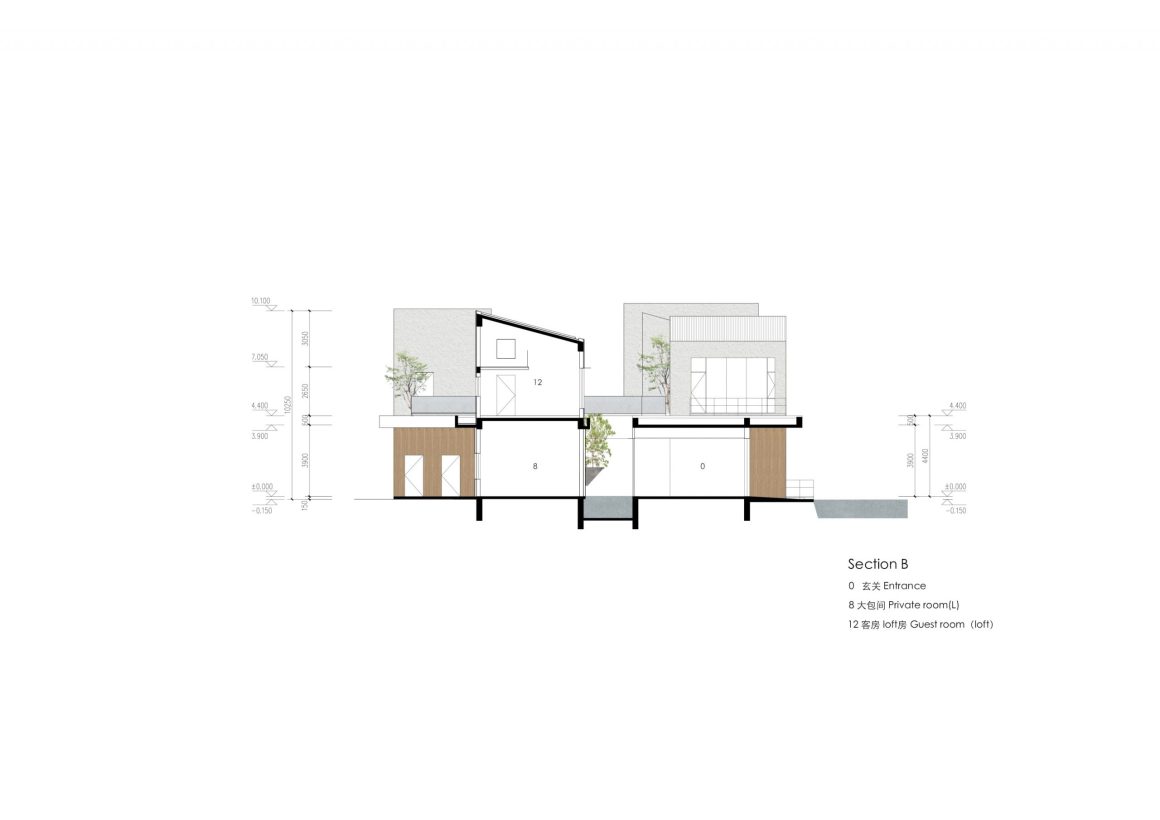
项目名称:江南半舍民宿
项目地点:昆山市计家墩村
项目类型:民宿
建筑设计:B.L.U.E. 建筑设计事务所
建筑师:青山周平,藤井洋子,杨易欣,曹宇,陈璐(B.L.U.E. 建筑设计事务所)
室内设计:B.L.U.E. 建筑设计事务所
客户:江南半舍
建筑面积:1800㎡
建筑层数:2层
结构形式:钢筋混凝土框架结构
主要材质
室外:竹钢,白色肌理涂料,白色哑光金属屋面,镀锌钢板
室内:水磨石,水洗石,木饰面,米白色凹凸肌理涂料
设计周期:2019年1月——2019年10月
施工周期:2019年10月——2021年3月
摄影师:夏至
Project Name: BAN Villa
Project Location: Jijiadun Village, Kunshan City, China
Project Type: Boutique Guesthouse
Architect: Shuhei Aoyama, Yoko Fujii, Yixin Yang, Yu Cao, Lu Chen
Client: BAN Villa
Size: Two-storey
Building Area: 1800 ㎡
Design Period: 01.2019 – 10.2019
Construction Period: 10.2019 – 03.2021
Materials: (exterior) laminated bamboo, white stucco, matte white metal roofing, galvanized steel sheet / (interior) terrazzo, exposed aggregate concrete, wood, stucco
Photography Credit: Zhi Xia
“ 基于优越的自然环境,打造一个从传统水乡肌理中生长出来的,与自然更交融的空间。”
审稿编辑:王琪 -Maggie
更多 Read more about: B.L.U.E.建筑设计事务所



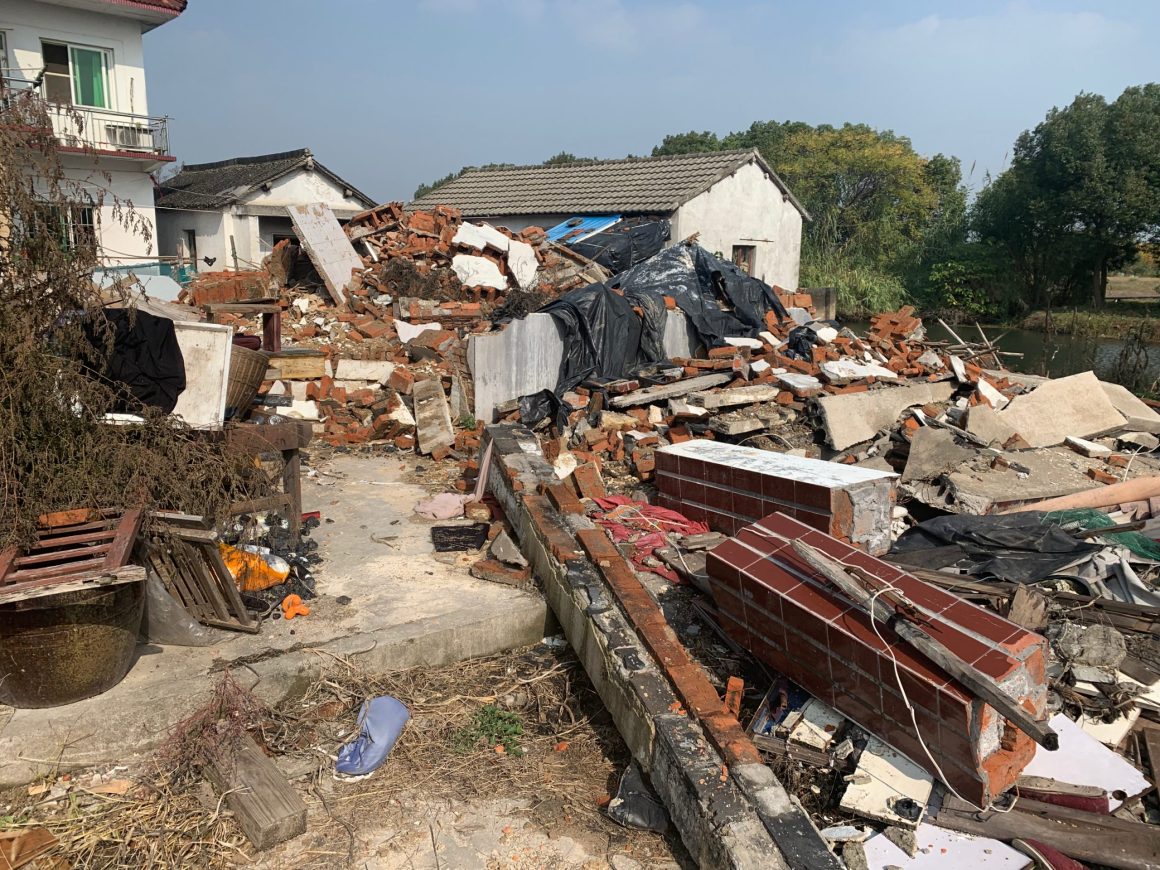
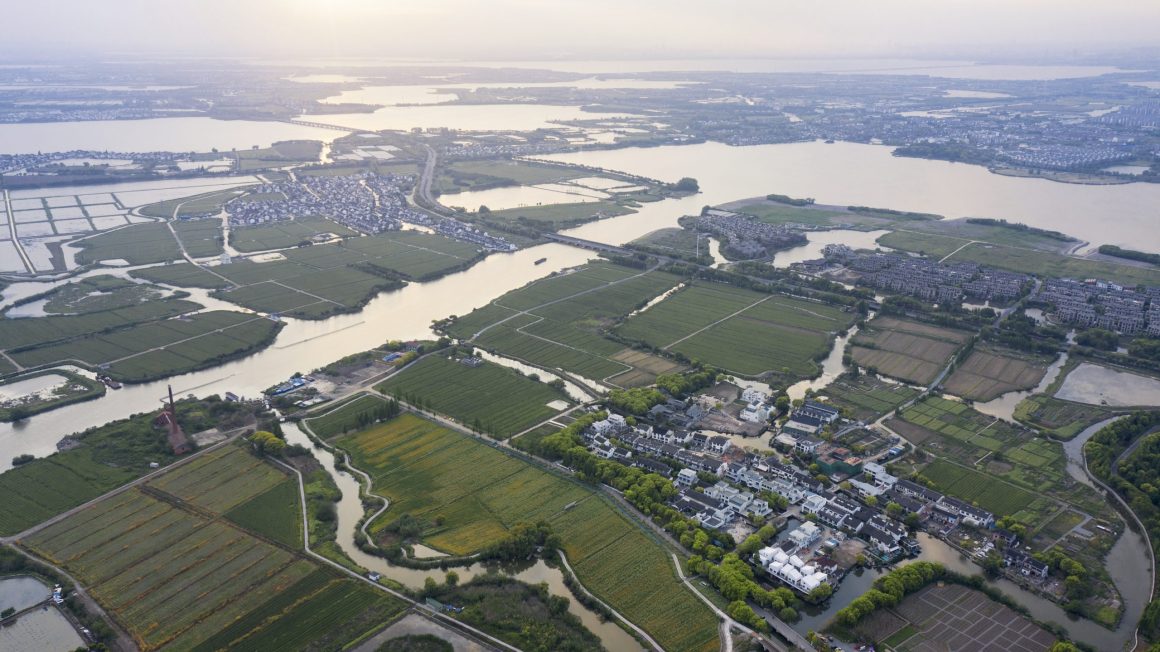


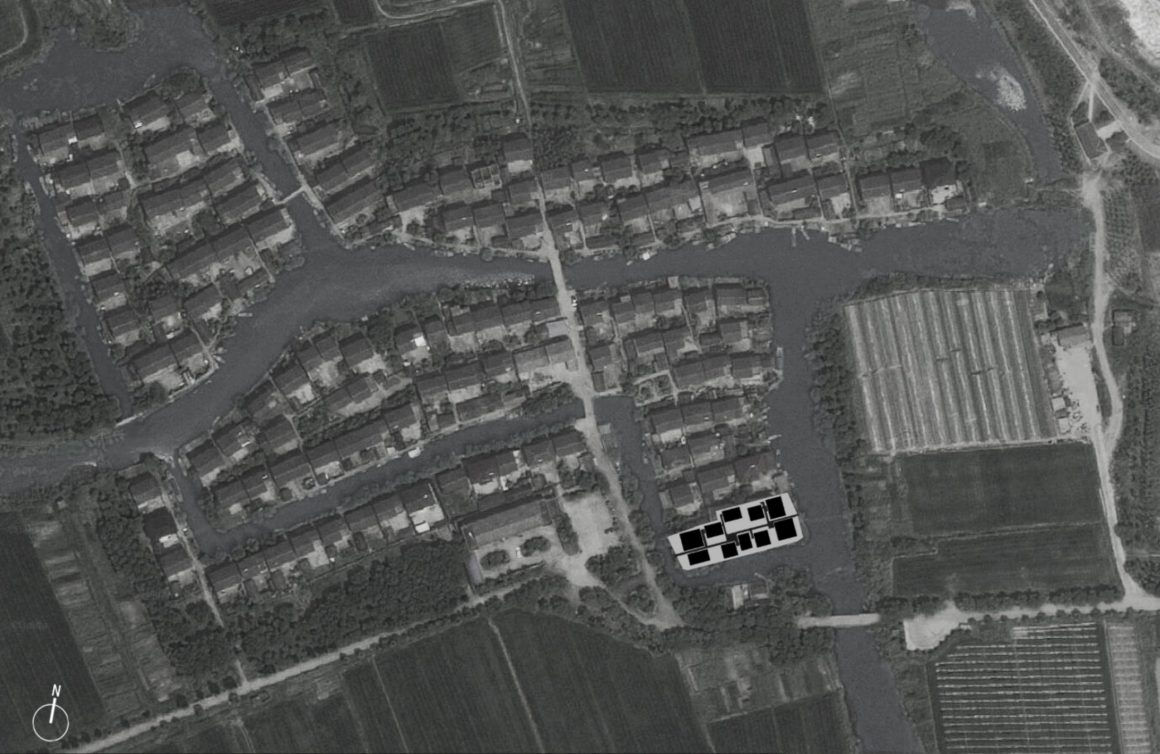
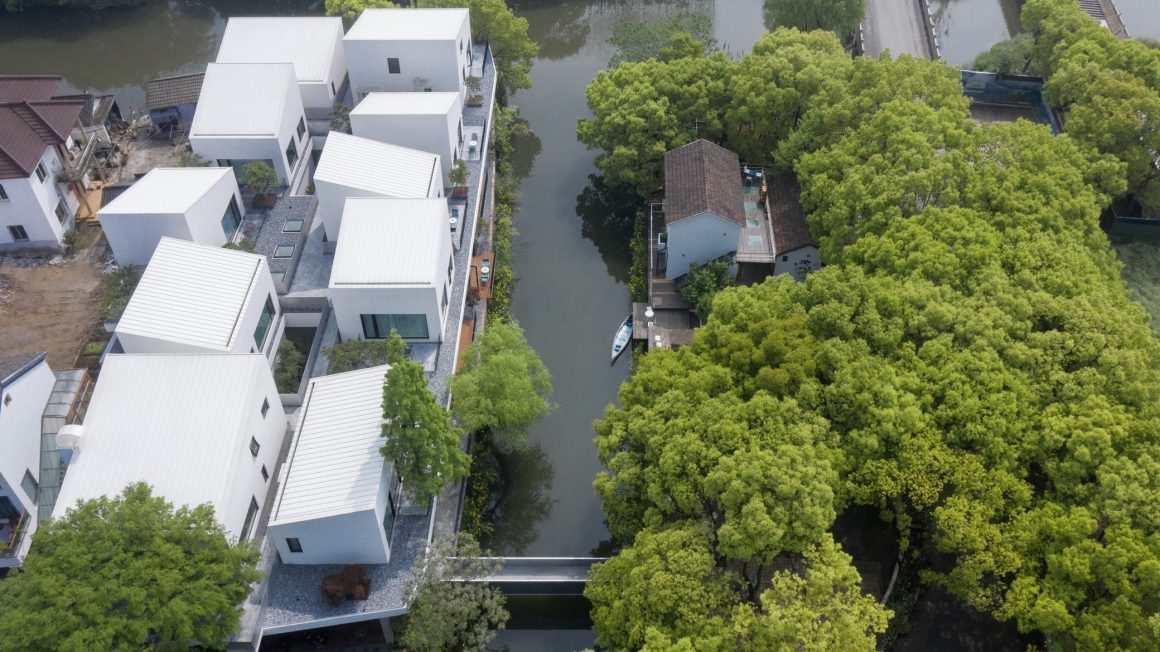


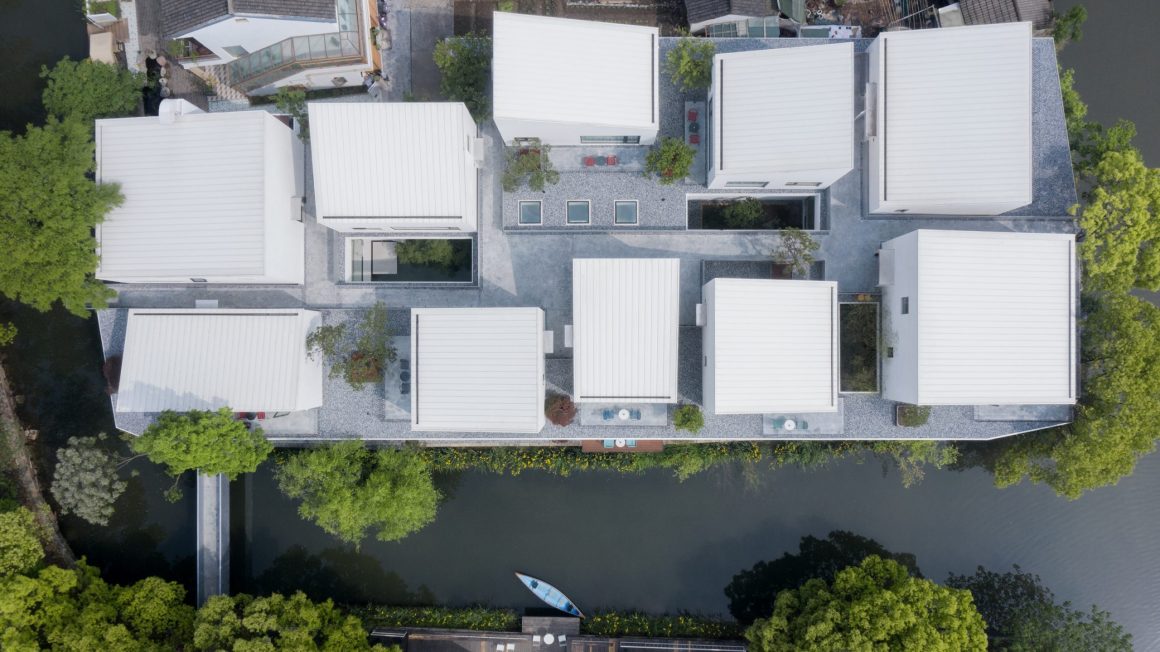
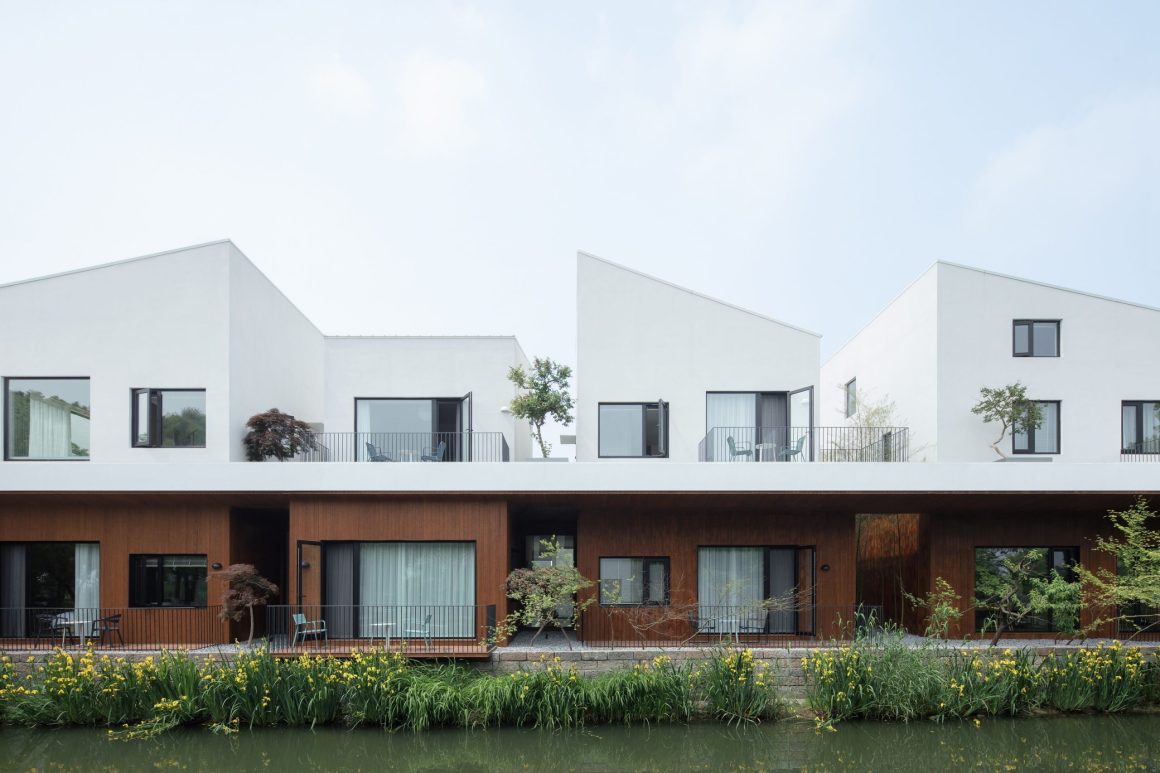
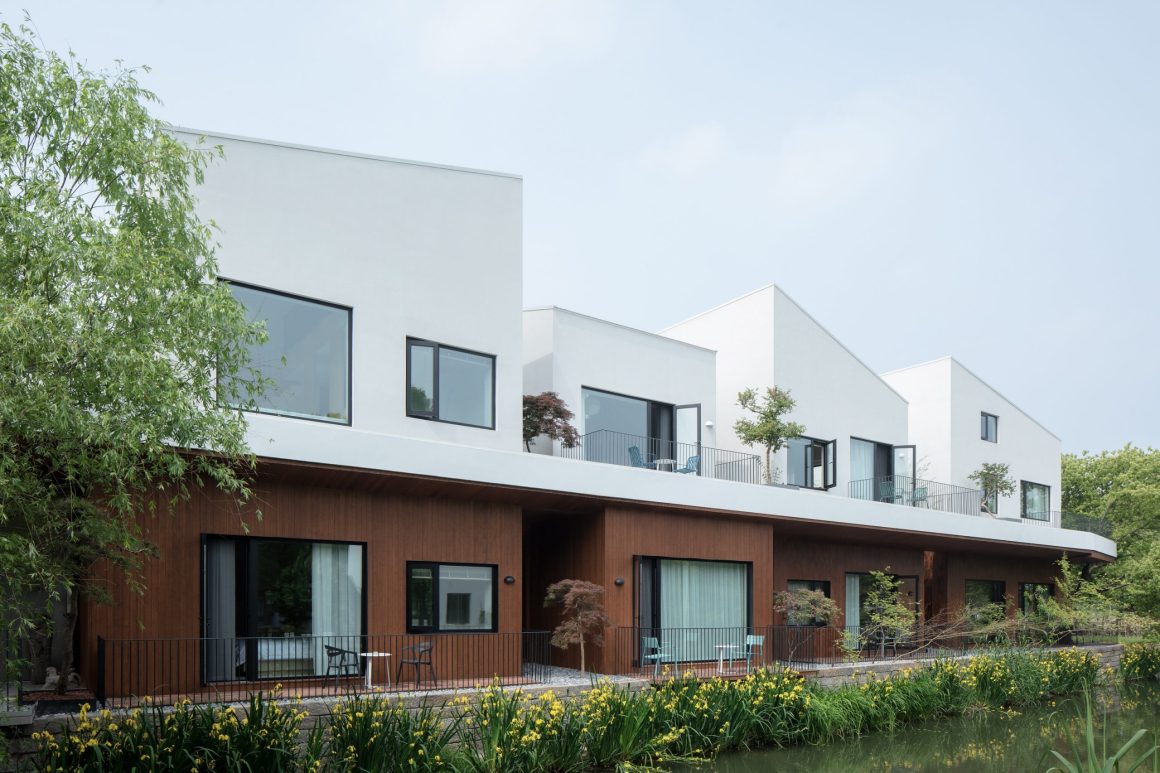

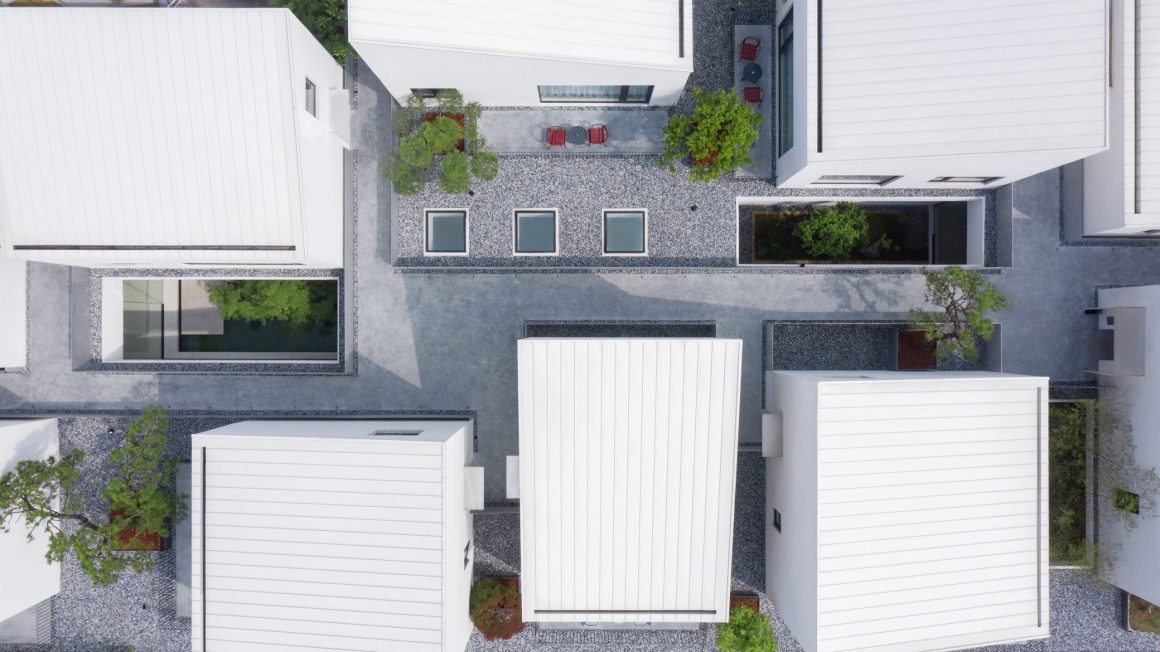
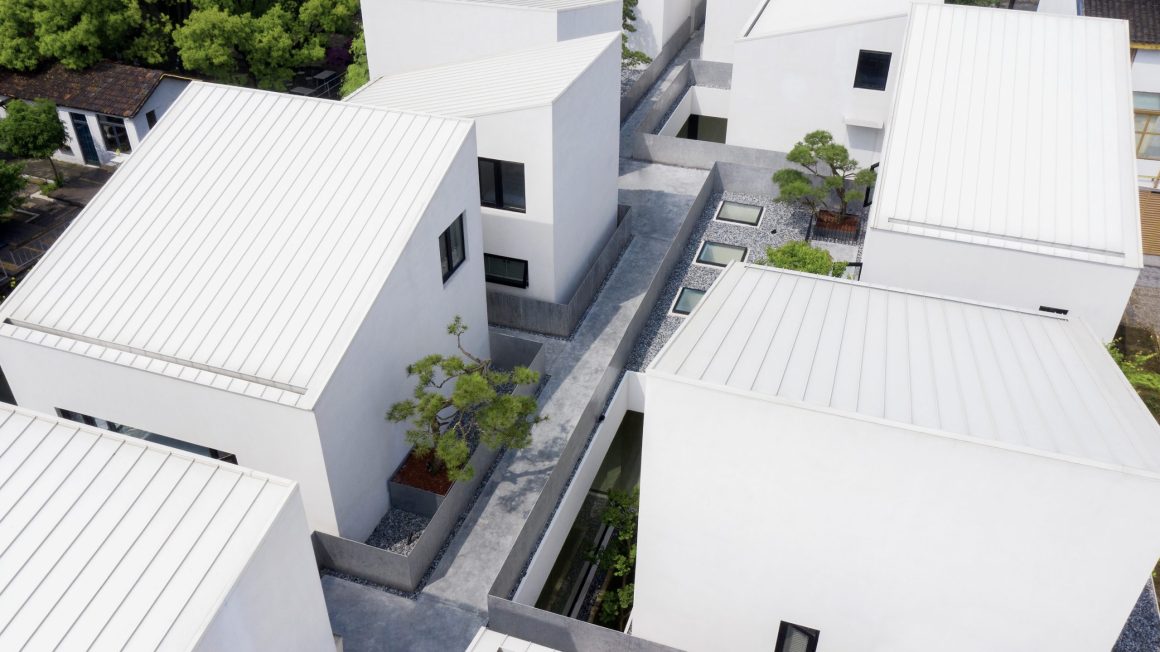

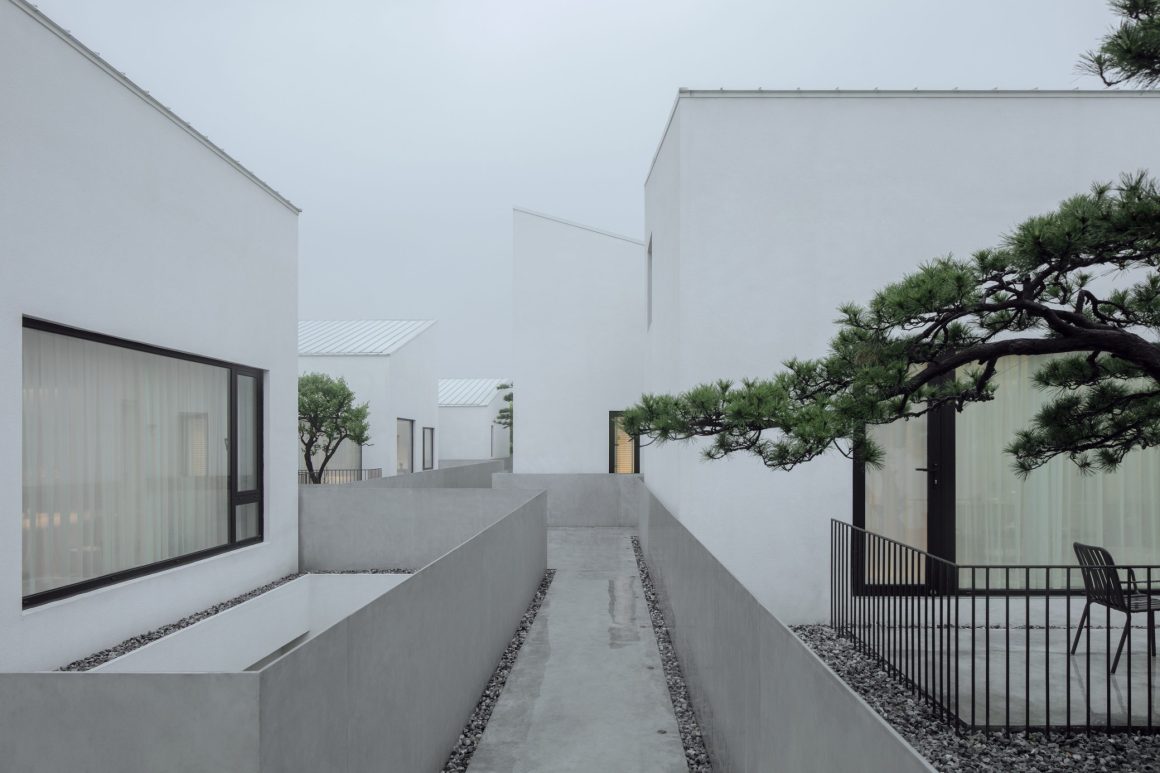



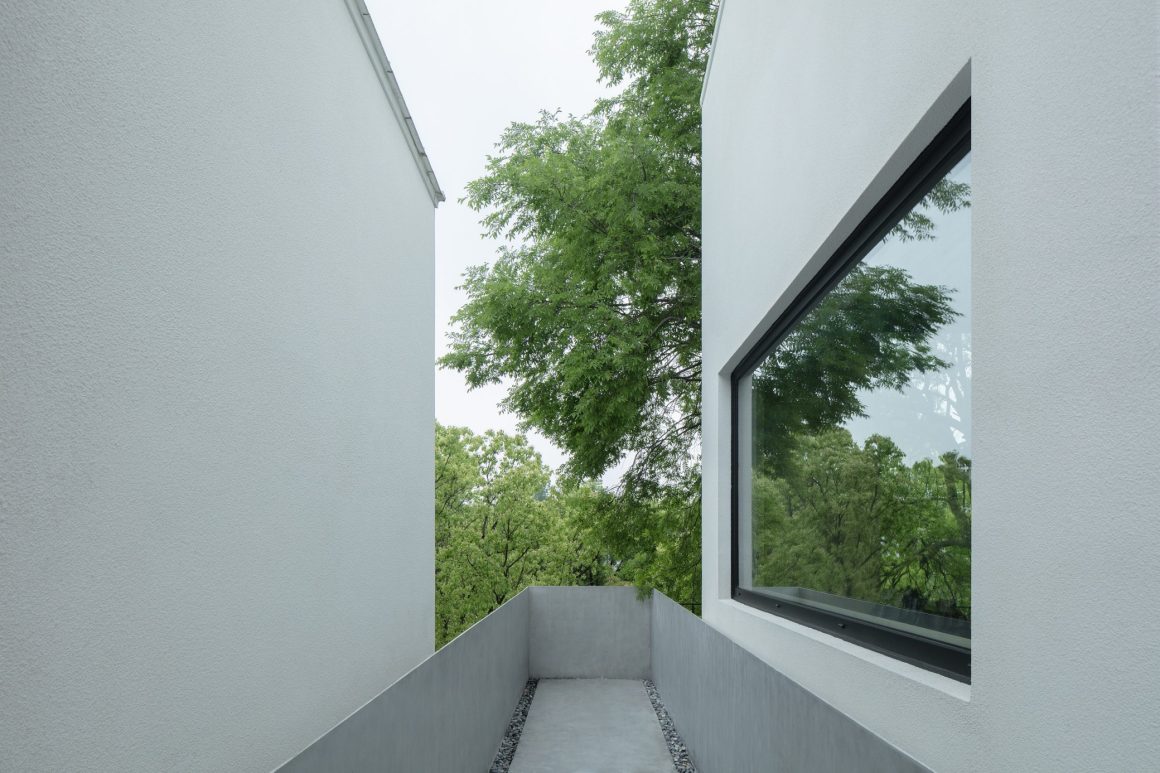


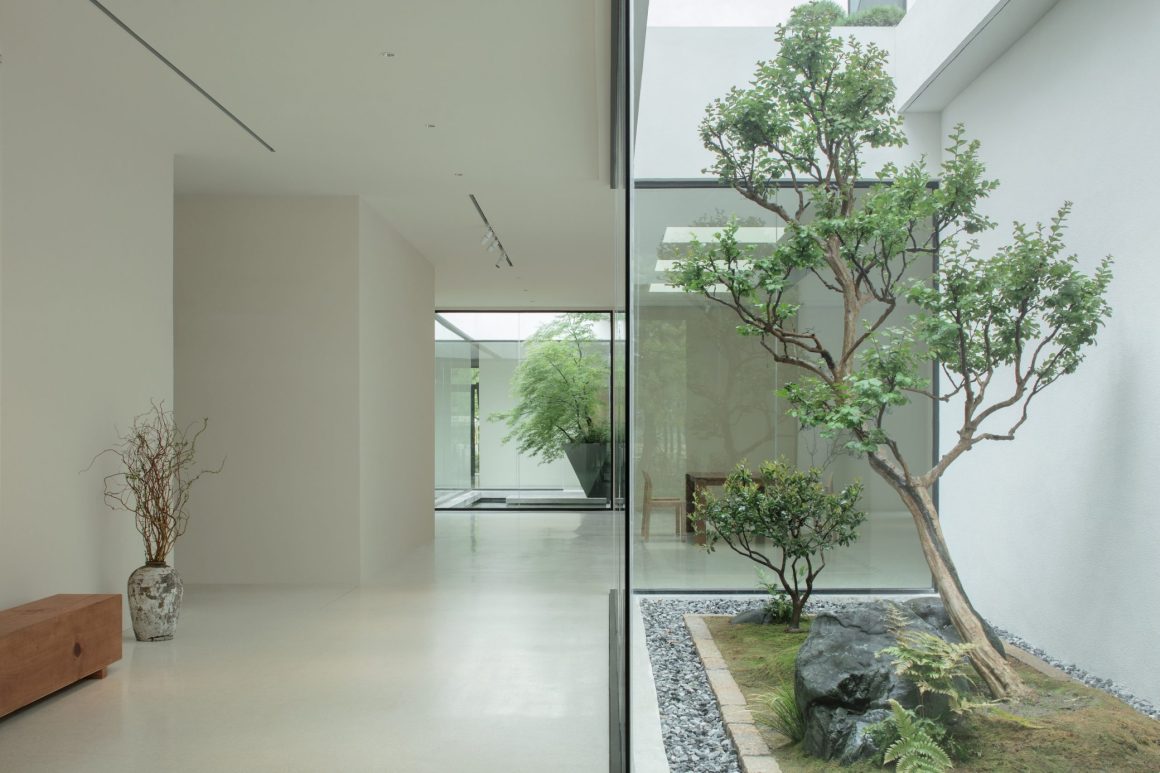

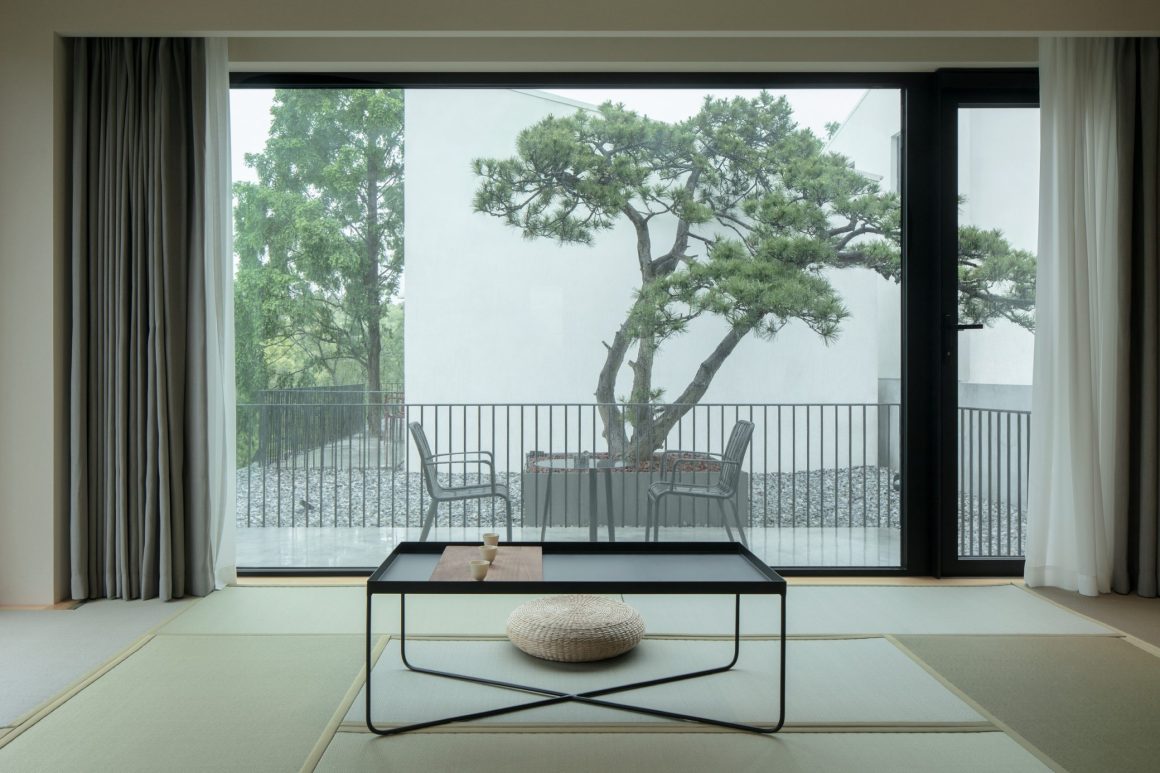

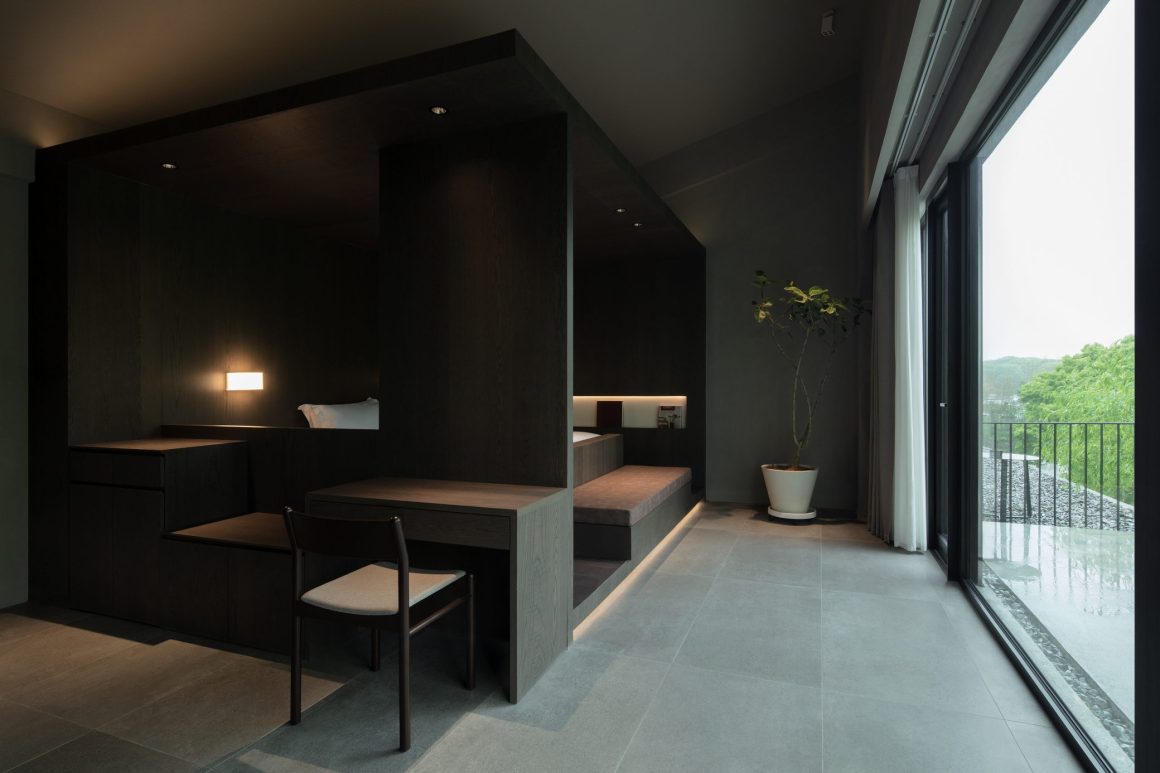
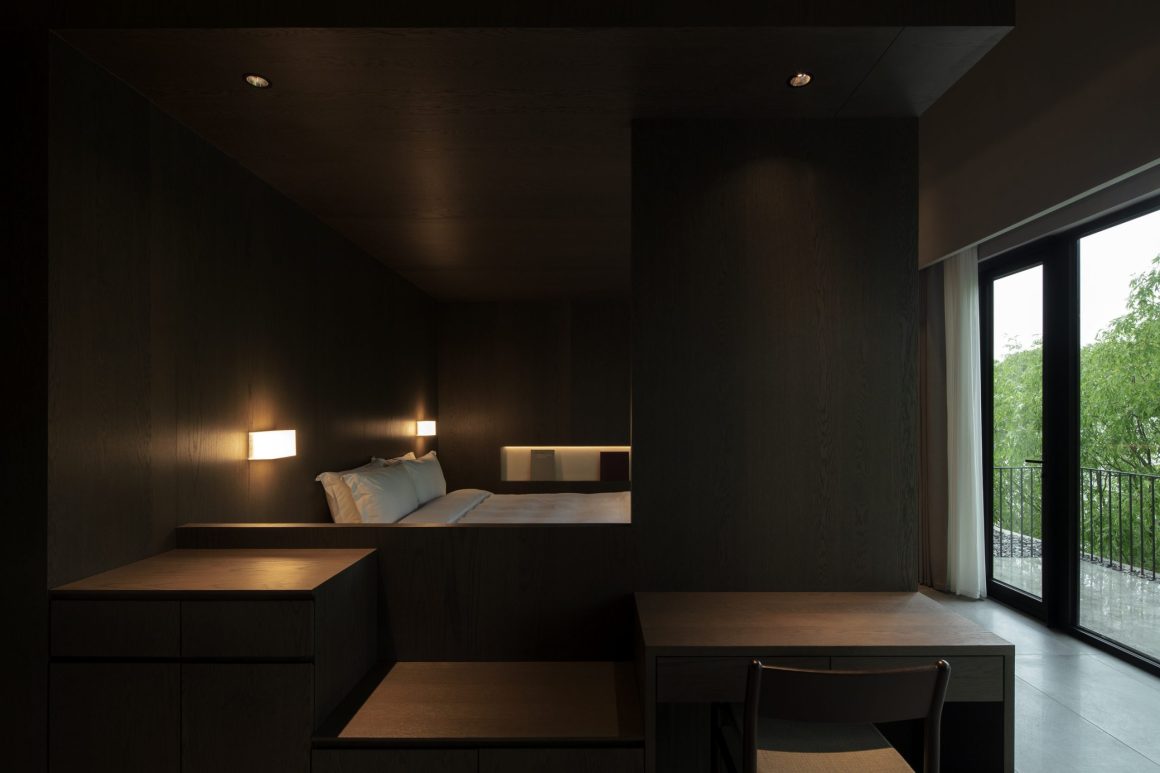
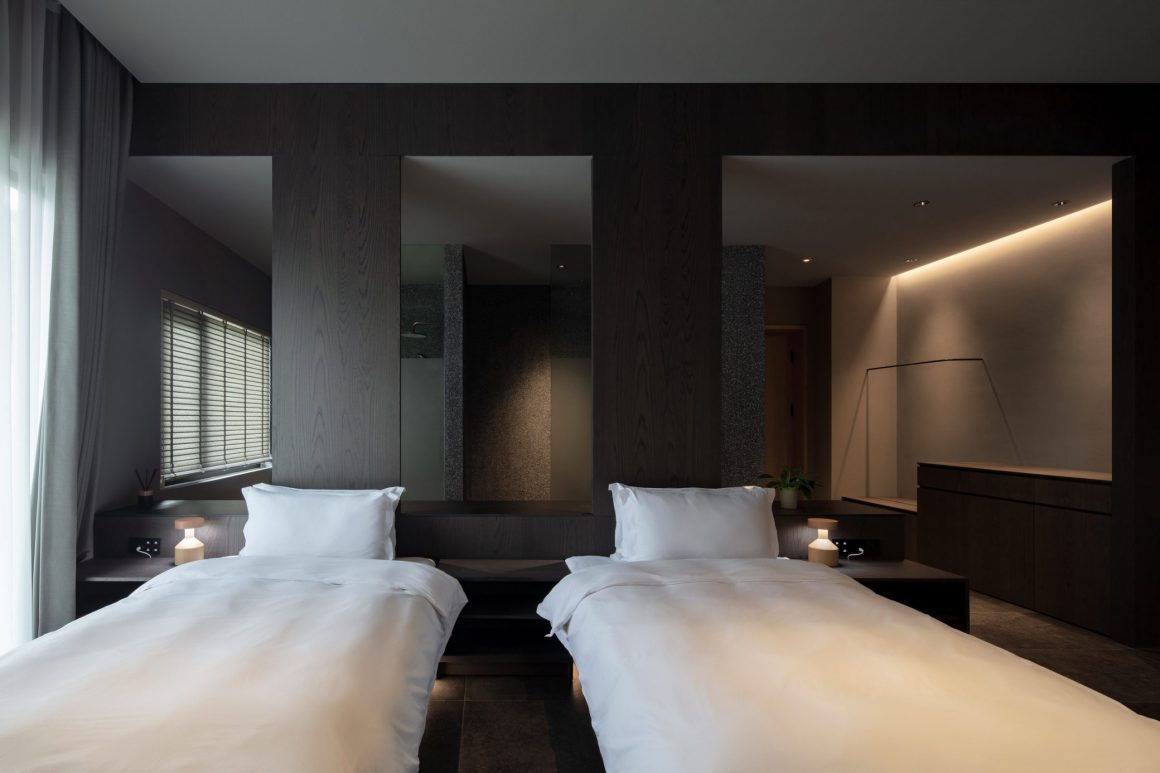


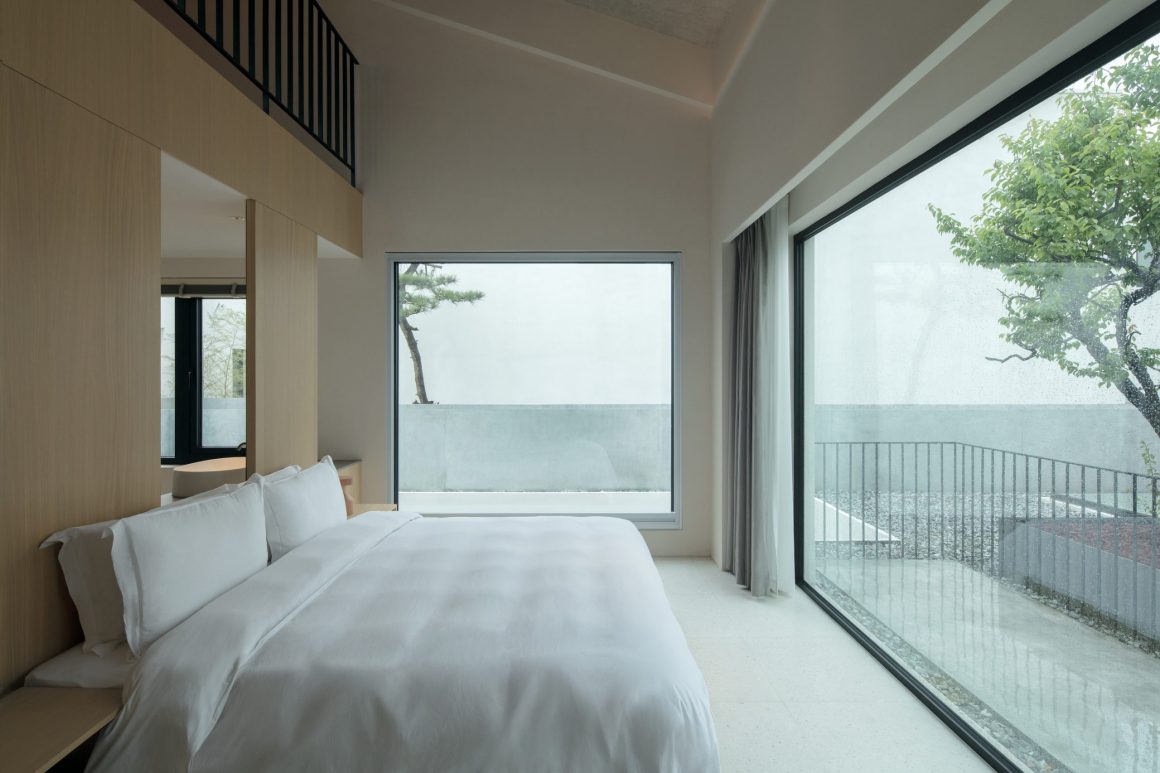
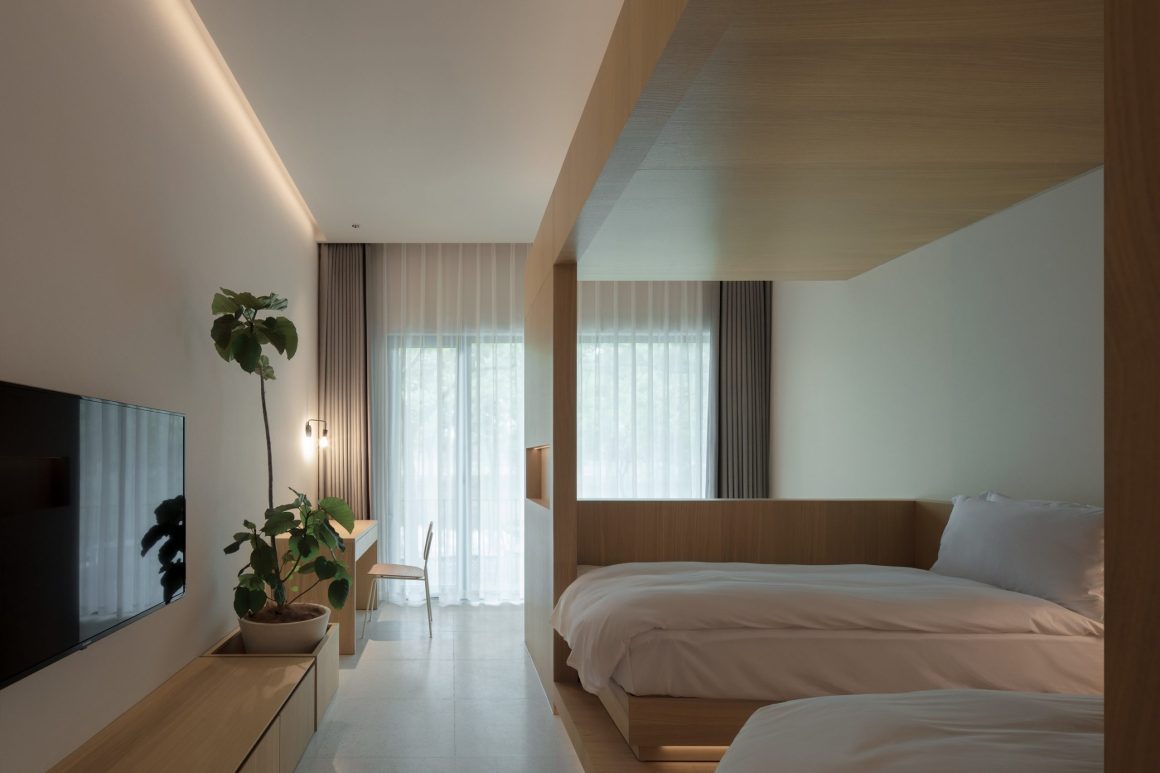

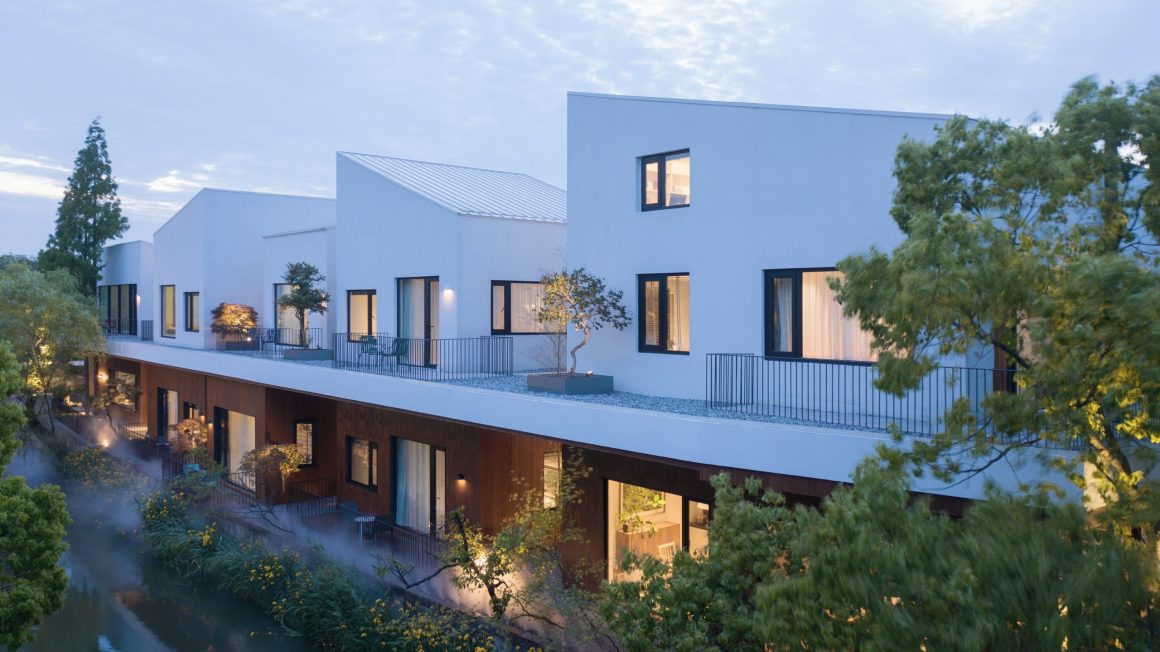
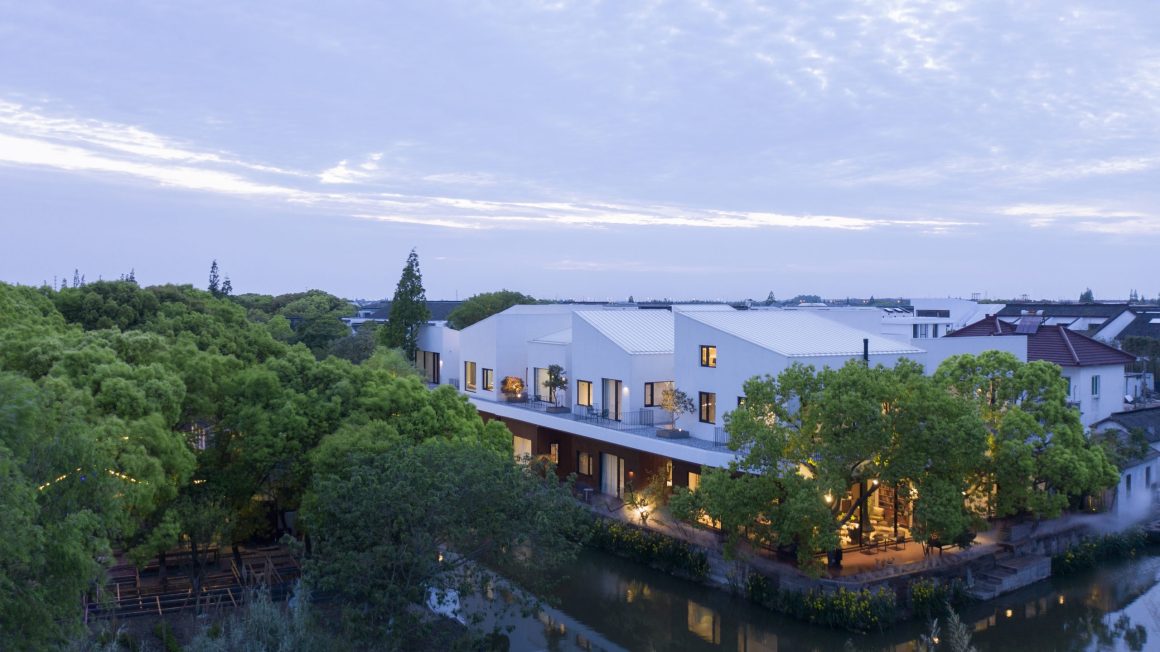
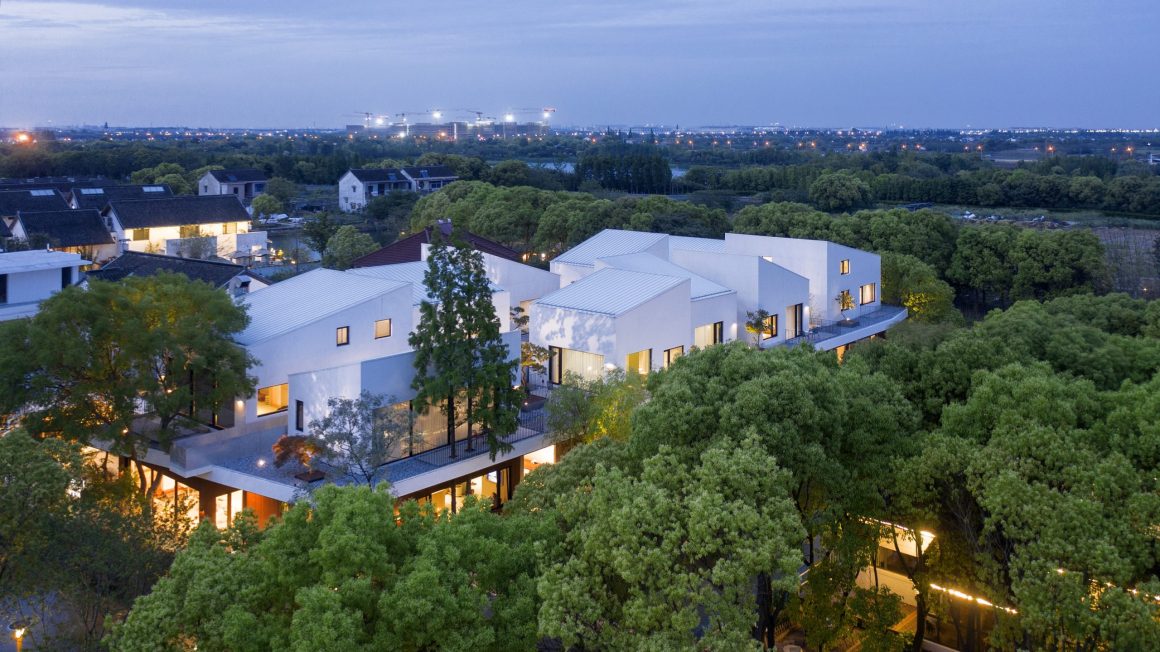


0 Comments